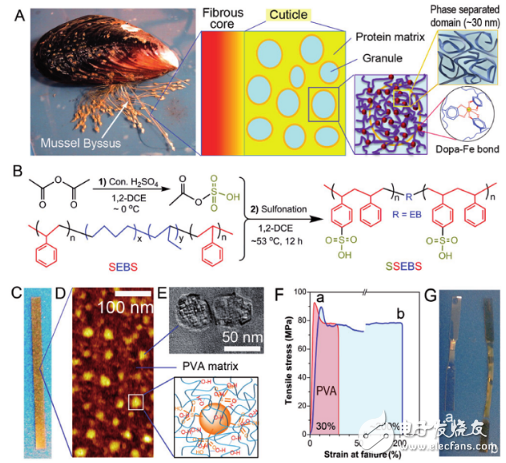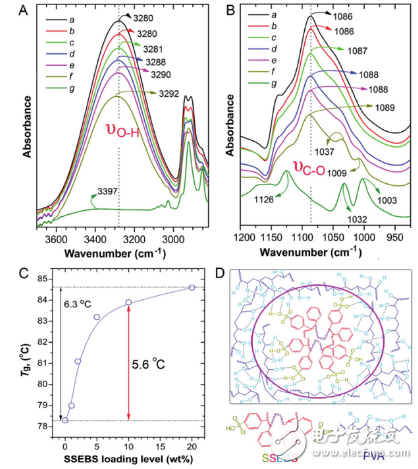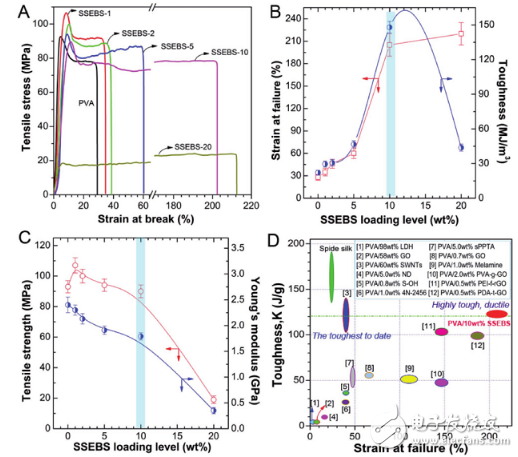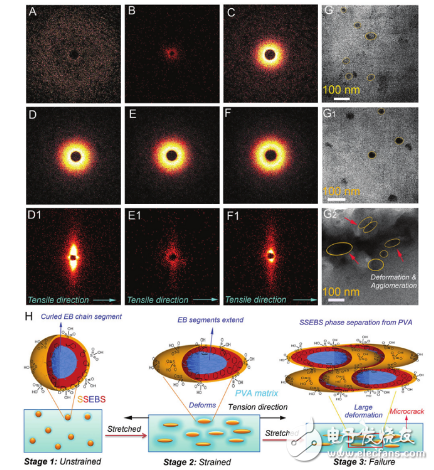Discussion on the development of high ductility and strength ultra-high polymer materials and industrial application technology research
Achieving high strength, large ductility and toughness is an important factor in the industrial application of polymer materials. However, so far, there is a common opposite trend in using material design strategies to improve these attributes, which remains a huge challenge. In nature, the stratum corneum of mussels exhibits a strain strain of up to 100%, which is caused by the architectural granular microphase separation structure within the protein matrix. This paper reports a simple biomimetic granular nanostructured polymer film. Compared with other polyvinyl alcohol films, this biomimetic nanostructured polymer film exhibits an ultra-high toughness of 122 (±6.1) J·g -1 , a strain at break of up to 205%, and a tensile strength of up to 91.2 MPa, which is superior to large Most engineering plastics. This outstanding combination of properties is attributed to the unique nanoscale granular phase separation structure of this material. These biomimetic polymer films are expected to be used in tissue engineering and biomaterials, such as artificial skin and tantalum, to provide a new way to create a range of innovative polymer materials for future applications.
[Introduction]Nowadays, due to its light and good mechanical properties, polymer materials are accelerating in the fields of automotive, electrical and electronics, aerospace and tissue engineering, and have great potential and will replace traditional metals and ceramics at a faster rate. material. The application conditions in these fields promote the development of strength, toughness and ductility required for new materials. Despite the recent fabrication of super-strength and rigid polymer nanocomposites based on graphene oxide nanosheets by mimicking the layered layering of natural nacres, they are mostly very brittle and have very low strain at break (usually less than 10%). This is mainly because strength, toughness and ductility are controlled by different mechanical mechanisms and are usually mutually exclusive. On the other hand, the introduction of nanoscale or microscale modifiers to impart polymers with enhanced toughness and ductility has traditionally resulted in a significant reduction in tensile strength of the polymer matrix. Therefore, to date, creating advanced polymer materials that combine high tensile strength, high ductility, and high fracture toughness remains a difficult problem.
Recently, Professor Qipeng Guo from Deakin University in Australia and Professor Pingan Song from Zhejiang Agriculture and Forestry University (co-author) and others published an article on Adv.Mater entitled "Granular Nanostructure: A Facile BiomimeTIc Strategy for the Design of Supertough Polymeric Materials with High DucTIlity and Strength" article. It addresses how to make advanced polymer materials with the required levels of high strength, high ductility and greater toughness. In this work, a super-abrasive and high-toughness polyvinyl alcohol with high strength was developed by adding a granulated nano-body group of a sulfonated styrene-ethylene/butylene-styrene triblock copolymer (SSEBS). (PVA) film. For a granular nanostructured PVA film containing 10 wt% of SSEBS, it has a high tensile strength of 91.2 MPa, a toughness of 122 ± 6.1 J·g -1 , and a fracture strain at break of up to 205%. These mechanically superior, superabrasive and ductile polymer materials are expected to have great application prospects in aerospace, flexible artificial muscle and tissue engineering.
[Graphic introduction]Figure 1 SSEBS synthetic route scheme and its performance

A) Schematic representation of the microstructure and morphology of the marine mussel stratum corneum, which combines hardness above 110 MPa and strain at break up to 100%.
B) Schematic diagram of the synthetic route of the water-dispersed SSEBS.
C) PVA / 10 wt% SSEBS film.
D) AFM images showing PVA films of dispersed granular SSEBS nanodomains, SSEBS interacting with PVA through multiple hydrogen bonds.
E) TEM image of the phase separation domain of SSEBS by self-assembly driven by competitive hydrophilic-hydrophobic interactions.
F) a) tensile stress-strain curves of PVA and b) PVA / 10wt% SSEBS,
G) Corresponding digital image after mechanical breakage.
Fig. 2 Attenuated total reflection Fourier transform infrared spectroscopy of PVA, SSEBS and their mixtures

A) OH and B) CO or SO stretching vibration changes: a) PVA, b) SSEBS-1, c) SSBS-2, d) SSEBS-5, e) SSEBS-10, f) SSEBS-20 and g) SSEBS.
C) The glass transition temperature (Tg) of the PVA film as a function of the SSEBS loading level.
D) Schematic representation of the intermolecular multiple hydrogen bonding interaction between PVA and SSEBS.
Figure 3 Comparison of mechanical properties

A) Typical tensile curve.
B) Tensile strength and modulus.
C) Fracture and ductile strain of PVA and its blended film with SSEBS.
D) Comparison of toughness and strain at break of PVA / SSEBS films prepared by LBL self-assembly and direct solution casting strategies with other PVA composite films.
Fig. 4 SAXS scattering diagram and transmission electron microscope image of PVA and its blended film with SSEBS

A) PVA. B) SSEBS-1. C) SSEBS-2.
D, D1) SSEBS-5. E, E1) SSEBS-10.
F, F1) SSEBS -20. Before the tensile failure, D1, E1, and F1 represent the corresponding samples after the tension.
Transmission electron microscope image:
G) SSEBS is dispersed in water, SSEBS-10. G1) before stretching; G2) after stretching failure.
H) Schematic diagram of the mechanical toughening mechanism of SSEBS in a PVA system.
ã€summary】In summary, the researchers successfully designed advanced polymer membranes with high toughness and large strain at break by simulating the granular microstructure of the marine mussel cuticle. The prepared granular nanostructured PVA film exhibits a super toughness of 122 (±6.1) J·g -1 , which is the highest in the world compared with other PVA films, and has a high failure strain of up to 205%, which is PVA prepared by any other method. The membranes are much higher. In addition, it maintains tensile strength above 91 MPa and is still much higher than most engineering plastics. Another benefit of the law is that it can be produced on a large scale. This advanced PVA film is expected to be used in tissue engineering. This work provides an easy way to design a powerful polymer material that combines high ductility and toughness.
Easy Electronic Technology Co.,Ltd , https://www.yxpcelectronicgroups.com